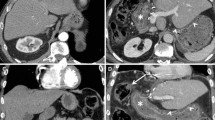Abstract
Purpose
This study was aimed to analyze the contrast-enhanced CT features of gastrohepatic ligament (GHL) involvement in gastric carcinoma (GC) and to evaluate the influence of GHL on the spread of GC correlating with the anatomic bases.
Methods
CT scans of 41 patients known to have GC and GHL involvement were reviewed retrospectively for the primary tumor and the GHL abnormalities, as well as the role GHL played in the spread of GC. Emphasis was placed on direct invasion, lymph node metastasis, and GHL seeding. The relationship between the accompanying ascites and the different pattern of the GHL involvement were also evaluated statistically.
Results
CT features of the GHL abnormalities caused by GC could be summarized as follows: (a) direct invasion (34.1%, 14 of 41), which was visualized as a regional (nine of 14) or diffuse mass (five of 14) in the GHL; (b) GHL seeding (26.8%, 11 of 41), which consists of ‘‘smudged’’ appearance (eight of 11), nodular infiltration (two of 11) and “GHL caking” (one of 11); (c) lymph node metastasis (63.4%, 26 of 41), including enlargement of lymph nodes (22 of 26) and cystic lesion (four of 26). We also found direct extension of GC into the transverse fissure and/or the liver via the GHL in three patients. Ascites, which was found in ten patients, seemed to be associated with the pattern of seeding involvement.
Conclusions
GHL can be invaded by GC through several patterns and contrast-enhanced CT scan plays an important role in detecting GHL involvement in GC, which has a variety of CT manifestations. GHL may also serve as a potential conduit for the predictable spread of GC into the neighboring organs such as the liver.








Similar content being viewed by others
References
Kim S, Kim TU, Lee JW, et al. (2007) The perihepatic space: comprehensive anatomy and CT features of pathologic conditions. Radiographics 27:129–143
Yoo E, Kim JH, Kim MJ, et al. (2007) Greater and lesser omenta: normal anatomy and pathologic processes. Radiographics 27:707–720
Kim YH, Lee KH, Park SH, et al. (2009) Staging of T3 and T4 gastric carcinoma with multidetector CT: added value of multiplanar reformations for prediction of adjacent organ invasion. Radiology 250:767–775
Kim HJ, Kim AY, Oh ST, et al. (2005) Gastric cancer staging at multi-detector row CT gastrography: comparison of transverse and volumetric CT scanning. Radiology 236:879–885
Habermann CR, Weiss F, Riecken R, et al. (2004) Preoperative staging of gastric adenocarcinoma: comparison of helical CT and endoscopic US. Radiology 230:465–471
Fukuya T, Honda H, Hayashi T, et al. (1995) Lymph-node metastases: efficacy for detection with helical CT in patients with gastric cancer. Radiology 197:705–711
Williams PL, Bannister LH, Berry MM (1995) Gray’s anatomy, 38th edn. Edinburgh: Churchill Livingstone
DeMeo JH, Fulcher AS, Austin RF Jr (1995) Anatomic CT demonstration of the peritoneal spaces, ligaments, and mesenteries: normal and pathologic processes. Radiographics 15:755–770
Oliphant M, Berne AS, Meyers MA (1995) Direct spread of subperitoneal disease into solid organs: radiologic diagnosis. Abdom Imaging 20:141–147; discussion 148
Oliphant M, Berne AS, Meyers MA (1996) The subperitoneal space of the abdomen and pelvis: planes of continuity. Am J Roentgenol AJR 167:1433–1439
Meyers MA, Volberg F, Katzen B, et al. (1973) Haustral anatomy and pathology: a new look. I. Roentgen identification of normal patterns and relationships. Radiology 108:497–504
Meyers MA, Volberg F, Katzen B, et al. (1973) Haustral anatomy and pathology: a new look. II. Roentgen interpretation of pathological alterations. Radiology 108:505–512
Meyers MA, Oliphant M, Berne AS, et al. (1987) The peritoneal ligaments and mesenteries: pathways of intraabdominal spread of disease. Radiology 163:593–604
Jin H, Min PQ (2007) Computed tomography of gastrocolic ligament: involvement in malignant tumors of the stomach. Abdom Imaging 32:59–65
Tomimatsu H, Kanematsu M, Goshima S, et al. (2012) Uneven haustra on CT colonography: a clue for the detection of transperitoneal invasion from gastric cancer. Abdom Imaging 37:570–574
Jin H, Min PQ, Yang ZG, et al. (2008) A study of multi-detector row CT scan on greater omentum in 50 individuals: correlating with anatomical basis and clinical application. Surg Radiol Anat 30:69–75
Maruyama K, Kaminishi M, Hayashi K, et al. (2006) Gastric cancer treated in 1991 in Japan: data analysis of nationwide registry. Gastric Cancer 9:51–66
Maehara Y, Kakeji Y, Oda S, et al. (2000) Time trends of surgical treatment and the prognosis for Japanese patients with gastric cancer. Br J Cancer 83:986–991
Sakuramoto S, Sasako M, Yamaguchi T, et al. (2007) Adjuvant chemotherapy for gastric cancer with S-1, an oral fluoropyrimidine. N Engl J Med 357:1810–1820
Tamura S, Miki H, Okada K, et al. (2010) Pilot study of a combination of S-1 and paclitaxel for patients with peritoneal metastasis from gastric cancer. Gastric Cancer 13:101–108
Acknowledgments
This work was supported by the Science Foundation of the 5th people’s Hospital of Shanghai (Grant No: 2010YJ10).
Author information
Authors and Affiliations
Corresponding author
Rights and permissions
About this article
Cite this article
Ge, MY., Yin, HB., Wan, KM. et al. Computed tomography of gastrohepatic ligament involvement by gastric carcinoma. Abdom Imaging 38, 697–704 (2013). https://doi.org/10.1007/s00261-013-9985-8
Published:
Issue Date:
DOI: https://doi.org/10.1007/s00261-013-9985-8




